|
Study on Design and Performance Prediction Methods for Miniaturized Stirling Engine
Design and manufacturing of a prototype engine

 Experimental system and experimental method
Experimental system and experimental method
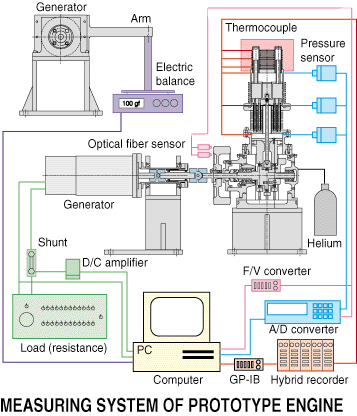 In order to examine the design method described previous page, experiments of the prototype engine are done using the experimental system like a right figure. The engine pressure is measured by strain type sensors, the temperature is measured by thermo couples. They are managed by a personal computer.
In order to examine the design method described previous page, experiments of the prototype engine are done using the experimental system like a right figure. The engine pressure is measured by strain type sensors, the temperature is measured by thermo couples. They are managed by a personal computer.
On the other hand, a D/C generator is setting an output shaft of the engine. In the case of the experiments, the capacity of the generator is too big, because the engine performance have to be estimated from low to high engine speed. The load is adjusted by varying of electric resistances which are connected the generator. Also, an arm is setting the generator like the right figure, and a shaft power is measured by an electric balance which is connected to the arm.
 Experimental condition
Experimental condition
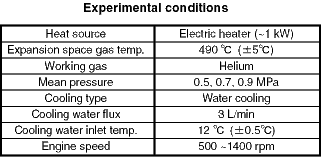 Experimental conditions are shown in a right table. A electric heater is used as a heat source, though the prototype engine has been designed using a combustion gas. Because the adjustment of the heat input to the engine becomes easily by the electric heater.
Experimental conditions are shown in a right table. A electric heater is used as a heat source, though the prototype engine has been designed using a combustion gas. Because the adjustment of the heat input to the engine becomes easily by the electric heater.
 Engine performance
Engine performance
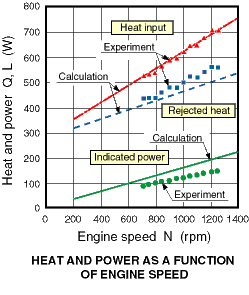 A right figure shows the calculated and experimental results of the relation between the engine speed and the effective heat input, the rejected heat and the indicated power.
A right figure shows the calculated and experimental results of the relation between the engine speed and the effective heat input, the rejected heat and the indicated power.
The calculated result of the effective heat input is simulated to the experimental result very well. But, it is difficult to decide that if the estimation of the heat losses is suitable or not. Because an accounting of the heat losses cannot be estimated in the experiments.
The caluclation of the rejected heat is considered that it is able to use the engine design, though the calculated result of the rejected heat is estimated lower than the experimental result slightly.
The calculated result of the indicated power is higher than the experimental result. It is caused by the calculation without the consideration of a gas leakage.
 Shaft power of the engine
Shaft power of the engine
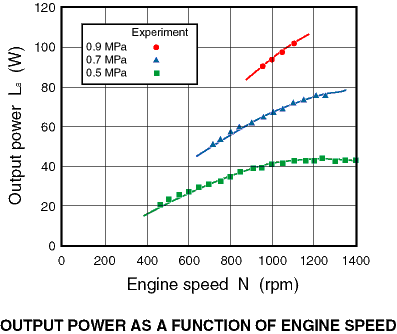 A right figure shows the experimental result of the relation between the engine speed and the output power at the mean engine pressure, 0.5 MPa, 0.7 MPa and 0.9 MPa. The prototype engine reachs the target power, 100 W at the mean engine pressure, 0.9 MPa and the engine speed, 1100 rpm.
A right figure shows the experimental result of the relation between the engine speed and the output power at the mean engine pressure, 0.5 MPa, 0.7 MPa and 0.9 MPa. The prototype engine reachs the target power, 100 W at the mean engine pressure, 0.9 MPa and the engine speed, 1100 rpm.
 Thermal efficiency of the engine
Thermal efficiency of the engine
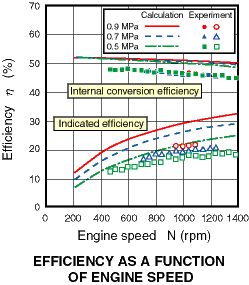 A right figure shows the calculated and experimental results of the relation between the engine speed and the internal conversion efficiency and the indicated efficiency. The calculated results of these efficiencies are estimated smaller than the experimental results. In the operation getting the maximum engine power, the experimental result of the indicated efficiency is 22 %.
A right figure shows the calculated and experimental results of the relation between the engine speed and the internal conversion efficiency and the indicated efficiency. The calculated results of these efficiencies are estimated smaller than the experimental results. In the operation getting the maximum engine power, the experimental result of the indicated efficiency is 22 %.
 Performance of the generator
Performance of the generator
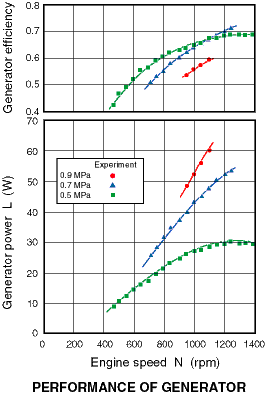 A right figure shows the experimental results of the relation between the engine speed and the generator power and the generator efficiency. The generator power increases accompanying the high engine speed. And the maximum of the generator efficiency is about 60 %.
A right figure shows the experimental results of the relation between the engine speed and the generator power and the generator efficiency. The generator power increases accompanying the high engine speed. And the maximum of the generator efficiency is about 60 %.
It is considered that the generator gets more high performance when the revolution speed is adjusted suitable.
 Heat transfer of the heater and cooler
Heat transfer of the heater and cooler
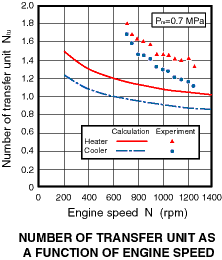 A right figure shows the calculated and experimental results of the relation between the engine speed and the number of heat transfer unit, NTU. The experimental result of NTU is pretty bigger than the calculated result, and the difference becomes bigger when the engine speed is high. As the cause, it is considered that the complex flow in the moving-tube-type heat exchangers are increased the heat transfer. Namely, the moving-tube-type heat exchanger has higher heat transfer characteristic than the normal shell-and-tube-type heat exchanger. Then, this heat exchanger is suitable type for the compact Stirling engine.
A right figure shows the calculated and experimental results of the relation between the engine speed and the number of heat transfer unit, NTU. The experimental result of NTU is pretty bigger than the calculated result, and the difference becomes bigger when the engine speed is high. As the cause, it is considered that the complex flow in the moving-tube-type heat exchangers are increased the heat transfer. Namely, the moving-tube-type heat exchanger has higher heat transfer characteristic than the normal shell-and-tube-type heat exchanger. Then, this heat exchanger is suitable type for the compact Stirling engine.
 Conclusion
Conclusion
(1) The prototype engine reachs the target engine power, 100 W and th eindicated efficiency, 22 %.
(2) The engine performance is able to be estimated on the whole by the calculated method with consideration of the heat losses.
(3) The moving-tube-type heat exchanger has the high heat transfer performance.
|  Experimental system and experimental method
Experimental system and experimental method Experimental condition
Experimental condition Engine performance
Engine performance Shaft power of the engine
Shaft power of the engine Thermal efficiency of the engine
Thermal efficiency of the engine Performance of the generator
Performance of the generator Heat transfer of the heater and cooler
Heat transfer of the heater and cooler Conclusion
Conclusion
 In order to examine the design method described previous page, experiments of the prototype engine are done using the experimental system like a right figure. The engine pressure is measured by strain type sensors, the temperature is measured by thermo couples. They are managed by a personal computer.
In order to examine the design method described previous page, experiments of the prototype engine are done using the experimental system like a right figure. The engine pressure is measured by strain type sensors, the temperature is measured by thermo couples. They are managed by a personal computer. Experimental conditions are shown in a right table. A electric heater is used as a heat source, though the prototype engine has been designed using a combustion gas. Because the adjustment of the heat input to the engine becomes easily by the electric heater.
Experimental conditions are shown in a right table. A electric heater is used as a heat source, though the prototype engine has been designed using a combustion gas. Because the adjustment of the heat input to the engine becomes easily by the electric heater.
 A right figure shows the calculated and experimental results of the relation between the engine speed and the effective heat input, the rejected heat and the indicated power.
A right figure shows the calculated and experimental results of the relation between the engine speed and the effective heat input, the rejected heat and the indicated power. A right figure shows the experimental result of the relation between the engine speed and the output power at the mean engine pressure, 0.5 MPa, 0.7 MPa and 0.9 MPa. The prototype engine reachs the target power, 100 W at the mean engine pressure, 0.9 MPa and the engine speed, 1100 rpm.
A right figure shows the experimental result of the relation between the engine speed and the output power at the mean engine pressure, 0.5 MPa, 0.7 MPa and 0.9 MPa. The prototype engine reachs the target power, 100 W at the mean engine pressure, 0.9 MPa and the engine speed, 1100 rpm.
 A right figure shows the calculated and experimental results of the relation between the engine speed and the internal conversion efficiency and the indicated efficiency. The calculated results of these efficiencies are estimated smaller than the experimental results. In the operation getting the maximum engine power, the experimental result of the indicated efficiency is 22 %.
A right figure shows the calculated and experimental results of the relation between the engine speed and the internal conversion efficiency and the indicated efficiency. The calculated results of these efficiencies are estimated smaller than the experimental results. In the operation getting the maximum engine power, the experimental result of the indicated efficiency is 22 %.
 A right figure shows the experimental results of the relation between the engine speed and the generator power and the generator efficiency. The generator power increases accompanying the high engine speed. And the maximum of the generator efficiency is about 60 %.
A right figure shows the experimental results of the relation between the engine speed and the generator power and the generator efficiency. The generator power increases accompanying the high engine speed. And the maximum of the generator efficiency is about 60 %. A right figure shows the calculated and experimental results of the relation between the engine speed and the number of heat transfer unit, NTU. The experimental result of NTU is pretty bigger than the calculated result, and the difference becomes bigger when the engine speed is high. As the cause, it is considered that the complex flow in the moving-tube-type heat exchangers are increased the heat transfer. Namely, the moving-tube-type heat exchanger has higher heat transfer characteristic than the normal shell-and-tube-type heat exchanger. Then, this heat exchanger is suitable type for the compact Stirling engine.
A right figure shows the calculated and experimental results of the relation between the engine speed and the number of heat transfer unit, NTU. The experimental result of NTU is pretty bigger than the calculated result, and the difference becomes bigger when the engine speed is high. As the cause, it is considered that the complex flow in the moving-tube-type heat exchangers are increased the heat transfer. Namely, the moving-tube-type heat exchanger has higher heat transfer characteristic than the normal shell-and-tube-type heat exchanger. Then, this heat exchanger is suitable type for the compact Stirling engine.